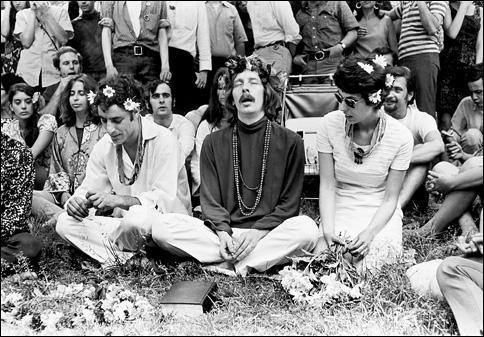The argument has been made that 1968 was the most tumultuous years in modern U.S. history. It is tough to disagree. The year marked seismic shift in American life and nothing would ever be the same
The changes didn’t occur overnight, although it seemed that way. It was no accident that the changes coincided with the first wave of Baby Boomers hitting their teen years. The music of the late 1960s was as eclectic and schizophrenic as the time. A pseudo-group called the Archies had a smash hit with Sugar, Sugar, but the music that would come to define the era was flying under the radar of the Billboard Top 100. Woodstock changed that. A couple of notes into Jimi Hendrix’s version of the Star Spangled Banner and you knew the Earth had shifted on its axis.
The assassinations of Martin Luther King, Jr. and Robert Kennedy in 1968 lit the fuse of the bomb that would blow society apart in what remained of the decade. The smoke and ash rained down throughout the 1970s and ripples from the initial explosion are felt today.
January 1969 gave subtle hints of things to come. Richard M. Nixon was sworn in as the 37th President of the United States on January 20, 1969. His election meant more young men would die in the jungles of Southeast Asia. Elvis Presley recorded “Long Black Limousine” in Memphis, Tennessee which kicked off his comeback. Jimi Hendrix appeared on a BBC1 show, “Happening for Lulu” and Led Zeppelin released their debut album. The BEATLES performed for the last time in public on the roof of the Apple building at 3 Saville Row in London.
Reflecting on 1969 is mind bending. Consider a year in which the U.S. put a man on the moon, and the era later dubbed the “Golden Age of Porn” (1969-1984) began. Sexuality explicit films shown in public on the big screen instead of on a bedsheet in someone’s dingy basement became reality with Andy Warhol’s 1969 film “Blue Movie.” The only X-rated film to win an Oscar®, “Midnight Cowboy” was released. At the time the X-rating didn’t mean the film was hardcore porn, all it meant was that the subject matter was unsuitable for underage people.
No retrospective of the 1960s is complete without addressing the Hippie aka Flower Power movement which reached a zenith during the summer of 1967 in San Francisco. The Human Be-In at Golden Gate Park on January 14, 1967 paved the way for the Summer of Love. The local underground newspaper, the San Francisco Oracle, offered the following description of the Be-In: “A new concept of celebrations beneath the human underground must emerge, become conscious, and be shared, so a revolution can be formed with a renaissance of compassion, awareness, and love, and the revelation of unity for all mankind.” A beautiful sentiment. It was an illusion.
The people who wandered the streets of San Francisco during the summer of 1967 smoking dope, dropping acid, tucking flowers into their hair and anointing themselves with Patchouli oil didn’t know that the Hippie movement was already on life support and about to flatline.
The cancer of drug dealers, pimps and others preying on the naivete of lost children looking for love and acceptance in Haight/Ashbury grew into an inoperable tumor. One cell of the malignancy had a name which, in two years’ time would become infamous, Charles Manson.

Charles Manson in court. [Photo courtesy LAPL]
The summer of 1969 had a few of the trappings of the Summer of Love, and it turned into a nightmare of violence and terror when word of murders of Sharon Tate, Abigail Folger, Jay Sebring, Wojciech Frykowski, Steven Parent, Rosemary and Leno LaBianca hit newsstands in mid-August.
For the next few months, as we approach the 50th anniversary of the brutal Tate/LaBianca murders, Deranged L.A. Crimes will intermittently look at some of the crimes that made news during 1969.
So, put on your love beads, memorize the lyrics to “Fixin’ to Die Rag,” and don’t bogart that joint. See you in the ’60s.




 Robert and Kendell described the day as the “happiest” of their lives. They paid no special attention to the “until death us do part” pledge. Following the ceremony a sheriff’s deputy placed handcuffs on each and led them to separate jail cells where they continued to fight extradition to California.
Robert and Kendell described the day as the “happiest” of their lives. They paid no special attention to the “until death us do part” pledge. Following the ceremony a sheriff’s deputy placed handcuffs on each and led them to separate jail cells where they continued to fight extradition to California.
 Robert’s behavior was bizarre, and the circumstances of Marcella’s death suggested homicide—she had a single stocking knotted around her neck. The police arrested the teenager on suspicion of murder.
Robert’s behavior was bizarre, and the circumstances of Marcella’s death suggested homicide—she had a single stocking knotted around her neck. The police arrested the teenager on suspicion of murder. Judge Robert Gardner to send Robert to Atascadero for 90 days or until he could assist in his own defense.
Judge Robert Gardner to send Robert to Atascadero for 90 days or until he could assist in his own defense. vice. When he finished, he phoned the police.
vice. When he finished, he phoned the police.





